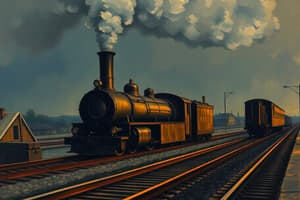Podcast
Questions and Answers
What is the standard gauge in train tracks?
What is the standard gauge in train tracks?
- 5 feet
- 3 feet 6 inches
- 4 feet 8.5 inches (correct)
- 6 feet
What is a transcontinental line?
What is a transcontinental line?
A railroad line that goes from the Pacific to Atlantic Oceans.
Standard time zones were created by major railroad companies.
Standard time zones were created by major railroad companies.
True (A)
What does the term 'national market' refer to?
What does the term 'national market' refer to?
What are national brands?
What are national brands?
What does A and P Stores stand for?
What does A and P Stores stand for?
Who was Thomas Edison?
Who was Thomas Edison?
Who developed the electric motor using alternating current?
Who developed the electric motor using alternating current?
Who was the financier who founded US Steel?
Who was the financier who founded US Steel?
What was the Sherman Antitrust Act?
What was the Sherman Antitrust Act?
The __________ Act made it illegal to manage separate companies under one director.
The __________ Act made it illegal to manage separate companies under one director.
What was the purpose of the Dawes Act?
What was the purpose of the Dawes Act?
The Ghost Dance was a Native American religious revitalization movement.
The Ghost Dance was a Native American religious revitalization movement.
What did the Gilded Age refer to?
What did the Gilded Age refer to?
Match the following figures with their contributions:
Match the following figures with their contributions:
What was the Great Railroad Strike of 1877?
What was the Great Railroad Strike of 1877?
Study Notes
Standardization and Expansion of Railroads
- Standard gauge: Established at 4 feet 8.5 inches in 1886, standardized track width allowed interoperability between rail companies.
- Transcontinental line: By 1890, five railroad lines connected the Pacific and Atlantic Oceans.
- Standard time zones: Implemented by major railroad companies to organize schedules across the nation.
Economic Impact of Railroads
- National market: The financial health of railroads directly influenced the broader economy.
- National brands: Products became widely available across the U.S.; prominent examples include Ivory Soap and Quaker Oats.
Notable Retail and Mail Order Businesses
- A and P Stores: Known as the Atlantic and Pacific Tea Company, it was a nationwide grocery store chain.
- Sears and Roebuck: A Chicago-based firm selling goods via mail order, catering to rural families.
Pioneering Inventors and Their Contributions
- Thomas Edison: Innovator with inventions like the lightbulb, phonograph, and a system for electricity distribution, despite limited formal education.
- Nikola Tesla: Developed the electric motor and promoted alternating current systems.
Business and Economic Practices
- Trusts: Legal management of multiple companies under a single director, influencing various industries.
- J.P. Morgan: Founded U.S. Steel in 1901 through the consolidation of eight major steel companies.
- Standard Oil: Formed in 1870 by John D. Rockefeller, it became a massive oil monopoly, controlling 90% of the industry through aggressive competition.
Industrial and Economic Models
- Vertical integration: Andrew Carnegie's concept for controlling all production phases in the steel industry, enhancing efficiency and profits.
- Horizontal integration: John D. Rockefeller's strategy of acquiring competing companies to establish a monopoly.
Social Commentary and Literature
- "The Theory of the Leisure Class": Thorstein Veblen criticized the upper class's spending patterns in this 1899 publication.
- "How the Other Half Lives": Jacob Riis highlighted poverty and poor living conditions through visual documentation.
Westward Expansion and Its Consequences
- Frederick Jackson Turner: Argued that the frontier had significant cultural implications for American identity.
- Homestead Act (1862): Provided land to settlers in the West, promoting family farming but later criticized as beneficial to whites at the expense of Native Americans.
Agricultural Developments and Challenges
- Bonanza farms: Large-scale farms employing numerous workers, representing a minority in the agrarian landscape.
- Long drives: The herding of cattle by cowboys, which declined due to changing agricultural practices and harsh weather conditions.
Native American Relations and Conflicts
- Chief Joseph: Leader of the Nez Perce, argued for equality during his tribe's forced relocation.
- Little Bighorn: A pivotal battle where Sioux and Cheyenne forces, led by Sitting Bull and Crazy Horse, defeated Custer’s troops.
Government Policies and Legal Challenges
- Bureau of Indian Affairs: Established to manage policies affecting Native Americans and create boarding schools for "Americanization."
- Dawes Act (1876): Divided tribal lands for individual families, aiming to assimilate Native Americans; resulted in significant loss of land ownership.
Social Unrest and Labor Movements
- Great Railroad Strike (1877): Marked the first nationwide strike in response to wage cuts, resulting in violent clashes.
- Knights of Labor: A significant labor organization of skilled and unskilled workers, advocating for workers' rights.
Economic and Political Reforms
- Sherman Antitrust Act (1890): Aimed to curb monopolistic practices but faced enforcement challenges due to vague language.
- Civil Service Act (1883): Established merit-based hiring for government jobs, reducing political machine influence.
Social Theories and Community Efforts
- Social Darwinism: Applied Darwin's theories of evolution to society, advocating for minimal government intervention in social issues.
- Social Gospel: Movement aiming to improve society through charity and reform within Protestant churches.
Cultural and Political Dynamics
- Gilded Age: Period known for economic growth contrasted by social inequality, named after Mark Twain's novel reflecting superficial prosperity.
- "Solid South": Characterized by the Democratic dominance in Southern politics for a century following the Civil War.
Studying That Suits You
Use AI to generate personalized quizzes and flashcards to suit your learning preferences.
Description
Explore the pivotal role of railroads in standardizing transportation and their profound economic impact on the United States. From the establishment of standard gauges to the rise of national brands, this quiz covers key facts and notable figures that shaped the railroad industry and retail businesses in the country.




